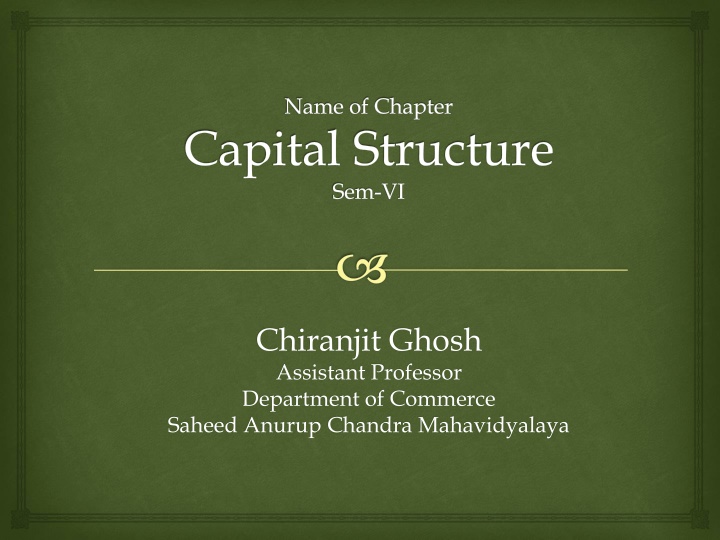
Capital Structure: Importance, Theories, and Differences
Explore the concept of capital structure, its importance, various theories, and differences such as financial vs. capital structure. Learn how firms use different sources of financing to maximize value and minimize risk.
Download Presentation

Please find below an Image/Link to download the presentation.
The content on the website is provided AS IS for your information and personal use only. It may not be sold, licensed, or shared on other websites without obtaining consent from the author. If you encounter any issues during the download, it is possible that the publisher has removed the file from their server.
You are allowed to download the files provided on this website for personal or commercial use, subject to the condition that they are used lawfully. All files are the property of their respective owners.
The content on the website is provided AS IS for your information and personal use only. It may not be sold, licensed, or shared on other websites without obtaining consent from the author.
E N D
Presentation Transcript
Name of Chapter Capital Structure Sem-VI Chiranjit Ghosh Assistant Professor Department of Commerce Saheed Anurup Chandra Mahavidyalaya
Introduction: The term Capital Structure implies the combination of sources which have been used for the creation of the pool of funds Financial Mix. A firm can fulfill its demand of finance by using different sources of financing whose costs are different. External Equity Debenture, Loan, Any other fixed periodic contractual obligation. Internal Equity Equity share capital, Retain earnings.
Capital Structure vs. Financial Structure Capital Structure Financial Structure Deals with long term capital only. - Owner Equity - Preference Share Capital - Long term debts Deal with both - long term capital as well as short term capital. - Owner Equity - Preference Share Capital - Long term debts - Current Liabilities Left hand side total of Balance Sheet A portion of left hand side of Balance Sheet
Importance: Minimization of Financial Cost. Maximization of Return. Minimization of Risk. Maintaining Control. Maximizing Firm s Value.
Theories of Capital Structure: Net Income (NI) Approach. Net Operating Income (NOP) Approach. Traditional Approach. Modigliani-Miller (MM) Approach.
Net Income (NI) Approach: Proposed by David Durand in 1959. Firm is able to increase its value (V) and decrease its cost of capital (k0) if it increases the ratio of Debt to Equity (i.e. Financial Leverage*). *firms ability to use fixed financial charges to magnify the effects of changes in EBIT on its EPS. The optimal capital structure is one at which k0 is minimum and V is maximum. The market price per share would be at its Maximum.


